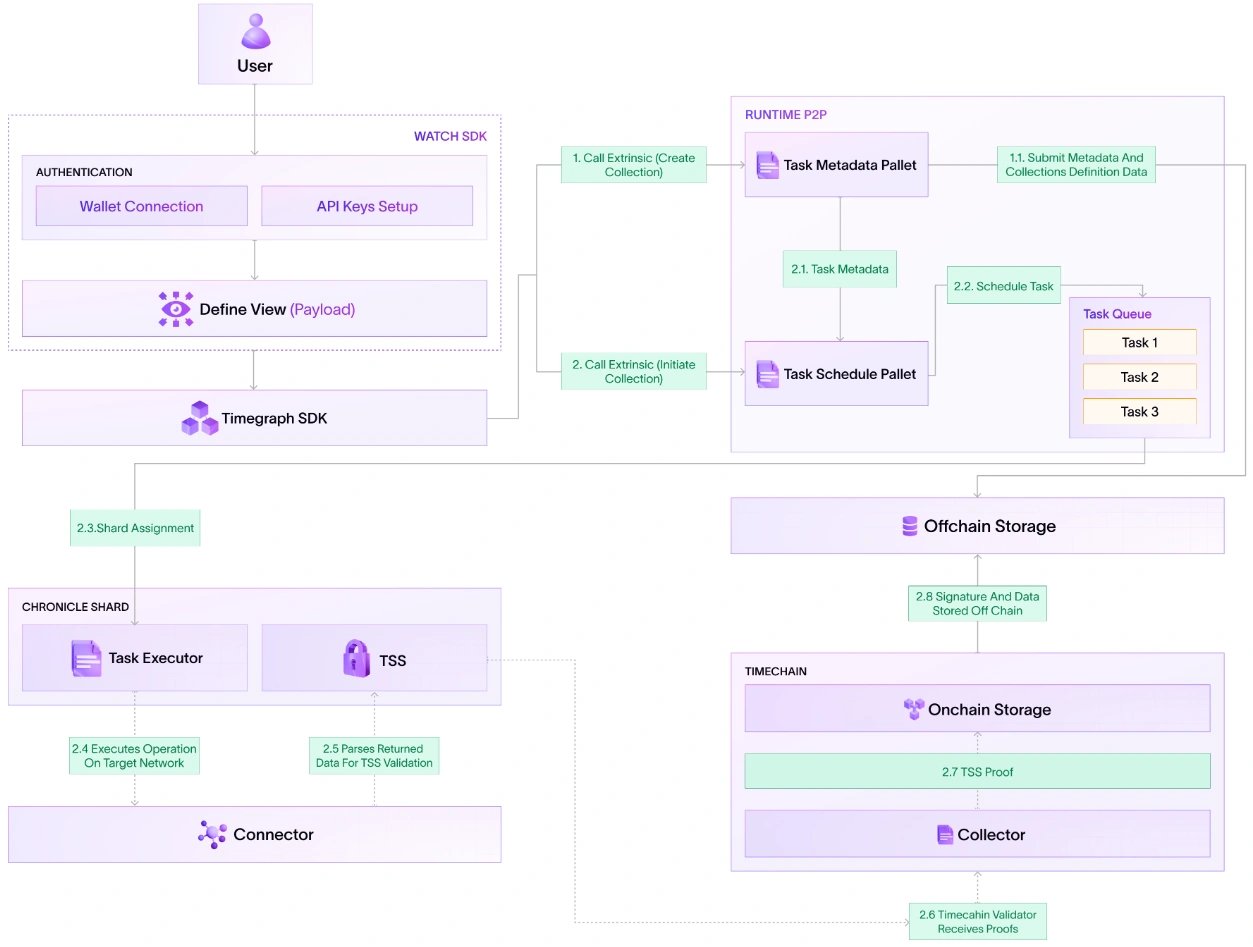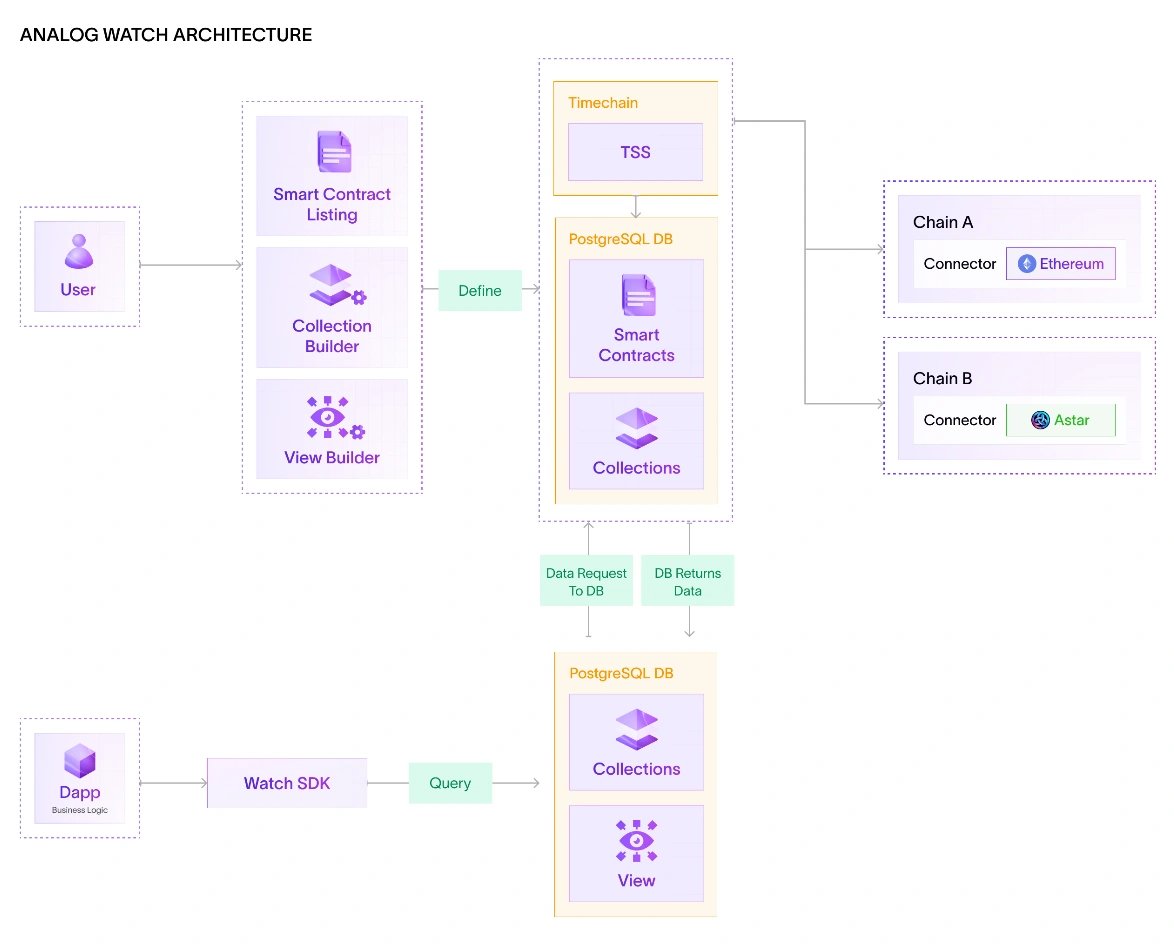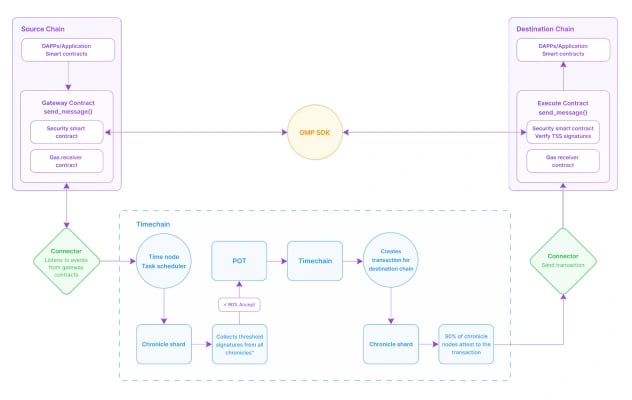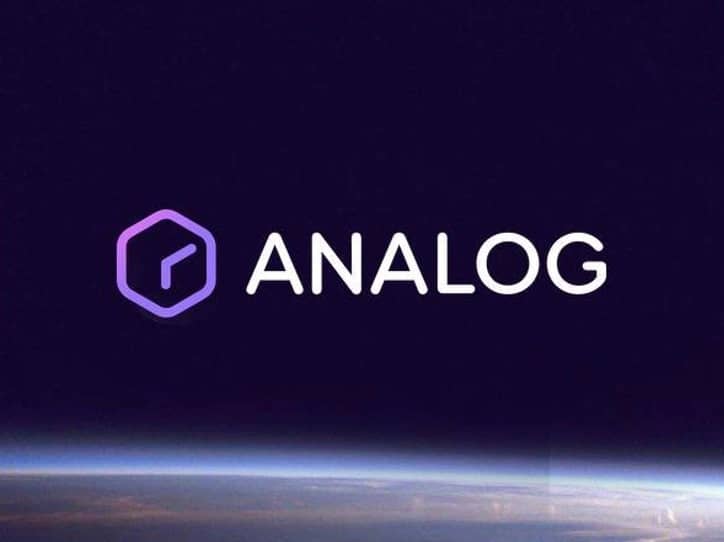위키 구독하기
Share wiki
Bookmark
Analog
Analog
**아날로그(Analog)**는 Substrate SDK(소프트웨어 개발 키트)의 지명형 지분 증명(Nominated Proof-of-Stake, NPoS) 기반으로 구축된 옴니체인 상호운용성 프로토콜입니다. 이 제품군은 Timechain이라는 NPoS 기반 원장을 중심으로 블록체인 생태계에서 DApp(탈중앙화 애플리케이션) 개발 및 크로스체인 통신을 위한 도구를 제공합니다.[1][2]
개요
빅터 영(Victor Young)이 2021년에 설립한 애널로그(Analog)는 보안, 투명성 및 포용성 향상을 목표로 기존의 합의 알고리즘에서 시간 증명(Proof-of-Time, PoT)으로 전환하는 데 전념하고 있습니다.[3] 애널로그의 핵심은 타임체인(Timechain), SDK 및 통합 API(Unified API)라는 세 가지 주요 구성 요소로 이루어져 있습니다. 합의 알고리즘에 종속되지 않는 프로토콜인 타임체인은 이 생태계의 기반을 형성합니다. 분산된 검증자에 의해 유지 관리되며, 크로스체인 트랜잭션의 무결성과 보안을 보장합니다. 타임체인을 보완하는 SDK는 개발자에게 사용자 친화적인 플러그 앤 플레이 도구를 제공합니다. 이러한 SDK는 타임체인에 연결되어 블록체인 데이터에 대한 액세스를 용이하게 하고 크로스체인 스마트 계약 실행을 가능하게 합니다. 통합 API(Unified API)를 사용하여 애널로그는 애널로그 지원 체인에서 스마트 계약을 쿼리하기 위한 단일 액세스 가능한 GraphQL 엔드포인트를 제공하여 개발을 더욱 간소화하고자 합니다.[4][5]
애널로그 네트워크는 타임 노드라고 알려진 일련의 검증자를 사용하여 다른 상호 연결된 체인을 모니터링하고 상호 작용합니다. 각 타임 노드는 크로니클 워커(Chronicle Worker) 및 커넥터(Connector)라고 하는 오프체인 모듈에 연결됩니다. 이러한 구성 요소는 다른 체인, 트랜잭션, 이벤트 로그 및 상태 변경 사항을 지속적으로 스캔합니다. 사용자 또는 애플리케이션이 연결된 체인에서 블록체인 데이터를 요청할 때마다 해당 체인의 모든 타임 노드는 이벤트를 타임체인으로 신속하게 전달할 수 있습니다. 이는 임계값 서명 체계(TSS)를 기반으로 하는 합의 프로세스를 트리거하여, 트랜잭션이 DPoS 알고리즘을 통해 추가 검증을 위해 타임체인으로 진행되기 전에 과반수 이상(활성 타임 노드의 3분의 2 이상)이 트랜잭션을 승인해야 합니다.[6]
또한 애널로그는 개발자 친화적인 Watch UI 및 SDK인 애널로그 워치(Analog Watch), PostgreSQL 데이터베이스 및 타임체인 기본 요소의 책임 메커니즘을 포함하는 기술 스택을 사용하여 DApp 개발자를 지원하는 데 중점을 둡니다. 개발자는 사용자 지정 크로스체인 보안 정책을 추가하여 유연성과 적응성을 보장할 수도 있습니다.[7]
주요 구성 요소
노드
시간 노드
크로니클 워커 (Chronicle Worker)
크로니클 워커 모듈은 임계값 서명 방식(TSS)을 오프체인으로 구현하고 타임체인 코어(Timechain Core)의 런타임과 협력합니다. 이 모듈은 여러 연결된 체인에서 계정을 집합적으로 관리합니다.
커넥터 (Connector)
커넥터는 시간 노드 운영자가 외부 체인 상태를 관찰하고 아날로그 네트워크에 변경 사항을 보고할 수 있도록 하는 루틴 기반 모듈입니다. 커넥터는 아날로그가 온보딩한 모든 블록체인에 대해 실행되어야 하며, 서비스에 대한 보상과 거래 수수료를 받습니다.
저장 노드
Analog Network는 검증된 이벤트 데이터를 온체인 트랜잭션에 저장하거나, 확장성 및 기밀성을 위해 오프체인 저장소에 저장합니다. 저장 노드는 이러한 오프체인 데이터를 유지 관리하여 데이터의 무결성과 가용성을 보장합니다. 사용자는 트랜잭션 크기에 따라 저장 수수료를 지불하며, 저장 노드는 과거 이벤트 데이터 트랜잭션으로부터 보상을 받습니다.
센티넬
아날로그 네트워크의 시간 노드 네트워크 외부에 있는 특수 노드입니다. 센티넬은 게이트웨이 스마트 계약 및 커넥터 서명을 모니터링하여 불법 활동을 감지합니다. 불법 활동이 감지되면 센티넬은 시간체인에 증거(사기 증명)를 제출하여 검증을 받을 수 있으며, 이는 위반하는 시간 노드에 대한 징벌적 조치로 이어질 수 있습니다.
건축 구성 요소
임계값 서명 방식 (TSS)
아날로그 네트워크의 TSS는 FROST 프로토콜을 기반으로 한 고급 서명 방식으로, 서명 프로세스를 간소화합니다. 이는 서명 권한을 여러 크로니클 작업자 그룹에 분산하여 유효한 서명을 생성하려면 최소 t + 1명의 작업자가 필요합니다.
이 TSS는 두 가지 주요 구성 요소를 포함합니다.
- KEYGEN: 공개 검증 키와 서명 키를 크로니클 작업자에게 할당하는 분산 키 생성 프로세스입니다. 이러한 키는 함께 비밀 키를 형성합니다.
- KEYSIGN: 외부 체인의 이벤트 데이터와 크로니클 작업자의 개인 입력을 사용하여 서명을 생성하는 분산 서명 알고리즘입니다.
확장성을 높이기 위해 네트워크는 크로니클 작업자를 최대 20명의 작업자가 있는 조각(shard)으로 나눕니다. 이러한 조각은 트랜잭션의 검증을 조정합니다.
악의적인 영향을 최소화하고 보안을 유지하기 위해 키 순환이 사용됩니다. 크로니클 작업자는 각 에포크(7.2시간마다) 후에 해당 조각 내에서 키를 순환하여 네트워크 복원력을 향상시킵니다. 준수하지 않을 경우 처벌하는 슬래싱 메커니즘이 있습니다.
스마트 계약
- 게이트웨이 스마트 계약: 연결된 체인의 dApp과 아날로그 네트워크의 애플리케이션 특정 계약 간의 중개자 역할을 하여 크로스체인 통신을 가능하게 합니다.
- 컨티뉴엄 스마트 계약: 이러한 스마트 계약은 Timechain에 상주하는 통합 인터페이스를 제공하여 dApp 개발을 간소화하고 외부 네트워크와 상호 작용할 때 유연성을 제공합니다.[6]
제품
아날로그 시계
아날로그 시계는 아날로그 네트워크의 필수 구성 요소로, Web3에서 데이터 접근성을 개선하고 단순화하는 것을 목표로 합니다. Timechain 인프라를 기반으로 구축된 풀스택 인덱싱 프로토콜로서, 나열된 스마트 계약으로부터 데이터를 인덱싱하기 위한 분산되고 암호화적으로 안전한 솔루션을 제공합니다.[8][9]
아날로그 워치 아티팩트
아날로그 워치의 중심에는 지원되는 체인의 블록체인 데이터와 상호 작용하기 위한 두 가지 핵심 아티팩트가 있습니다. "컬렉션(Collections)"으로 알려진 첫 번째 아티팩트는 스마트 계약에서 특정 데이터의 색인 생성 시 아날로그 네트워크 노드를 안내하는 청사진 역할을 합니다. 이러한 컬렉션은 GraphQL 엔드포인트를 통해 액세스할 수 있으며, 복잡한 입력에서 관련 정보만 찾아 데이터 검색을 간소화합니다. 두 번째 핵심 구성 요소인 "뷰(Views)"를 사용하면 여러 컬렉션의 데이터를 쿼리하는 로직을 생성하여 데이터 집계 기능을 향상시킬 수 있습니다.[10][11]

내부 프로세스
- 인증 및 세션 키: 사용자는 지갑 연결을 통한 인증 과정을 거칩니다. 인증 성공 후, Analog Watch 접근을 위한 디지털 키 역할을 하는 세션 키(SSK)를 생성합니다.
- 컬렉션 생성: 컬렉션은 스마트 계약으로부터 사용자가 원하는 특정 데이터를 지정하는 필터 역할을 합니다. 사용자는 데이터 기본 설정을 명시하는 컬렉션 스키마를 생성합니다.
- 콜 익스트린직 생성: 컬렉션 스키마 생성 후, Analog Watch는 Timechain 네트워크에 대한 명령어를 포함하는 "콜 익스트린직"을 생성하는 기술적 측면을 담당합니다.
- Timechain 및 태스크 스케줄러: 시간 노드와 다양한 모듈로 구성된 Timechain 네트워크가 작동합니다. 태스크 메타데이터 팔레트는 컬렉션과 관련된 메타데이터를 PostgreSQL 데이터베이스에 오프체인으로 저장합니다.
- 태스크 스케줄 및 샤드: 태스크는 태스크 스케줄 팔레트를 통해 지정된 샤드로 예약 및 전달됩니다. 샤드는 Timechain 내의 더 작은 네트워크를 나타냅니다. 태스크 처리는 선입선출 방식을 따릅니다.
- 크로니클 워커 및 태스크 실행: 선택된 샤드 내에서 크로니클 워커가 태스크를 실행합니다. 외부 블록체인 네트워크와는 커넥터를 통해 상호 작용합니다.
- 데이터 집계 및 서명: 외부 블록체인에서 데이터를 가져온 후, 각 크로니클 워커는 샤드 내의 리드 크로니클 워커(수집기)에게 전송합니다. 수집기는 안전한 다자간 연산 과정의 일환으로 여러 크로니클 워커의 서명을 통합합니다.
- 임계값 서명 방식(TSS) 증명: 데이터 무결성을 보장하기 위해, 특정 수 이상의 크로니클 워커가 가져온 데이터를 승인해야 합니다. 이러한 과반수에 도달하면 수집기는 TSS 증명을 생성합니다.
- Timechain 합의: TSS 증명은 Timechain에 제출되어 합의 메커니즘을 통해 진위 여부가 검증됩니다. 이 검증 과정은 데이터가 변조되지 않았음을 보장합니다.
- 게시: 이제 검증된 데이터는 Timechain에 게시됩니다. 이 게시에는 메타데이터와 증명이 포함되며, 실제 데이터와 서명은 효율성과 보안을 위해 오프체인에 저장됩니다.
- 아티팩트와의 상호 작용: 사용자는 이후 자신이 생성한 아티팩트와 상호 작용할 수 있습니다. 이 상호 작용은 Watch SDK 또는 Watch UI를 사용하여 가능합니다. 이러한 도구는 다양한 애플리케이션에서 처리된 블록체인 데이터에 쉽게 접근하고 활용할 수 있는 방법을 제공합니다.[12]
Watch UI
Watch UI는 호스팅 서비스로, Analog Network의 기능을 활용하여 사용자에게 컬렉션 및 뷰를 게시하고 탐색할 수 있는 플랫폼을 제공합니다. 이 인터페이스는 블록체인 데이터와의 상호 작용을 간소화하여 API 키 생성, 컬렉션 및 뷰 배포, 스마트 계약 및 관련 데이터 탐색과 같은 기능을 제공합니다.[13]
Watch UI 주요 기능
- 단순화된 기능: 사용자는 컬렉션과 뷰를 손쉽게 배포하고 쿼리하여 다양한 지원 체인의 블록체인 데이터에 더 쉽게 접근할 수 있습니다.
- 강력한 인프라: Watch UI는 사용자가 자체 서버를 설정하고 복잡한 코드를 관리할 필요가 없도록 하여 확장 가능한 블록체인 데이터에 대한 접근을 제공합니다.
- 간편한 DApp 배포: 이 플랫폼을 통해 노드 실행 또는 인덱싱 솔루션 관리의 복잡성 없이 강력한 DApp을 생성할 수 있습니다.
- 포괄적인 접근: Watch UI는 사용자에게 직관적인 인터페이스를 통해 게시된 스마트 계약, 컬렉션 및 뷰를 포괄적으로 볼 수 있도록 합니다.[13]
Watch UI 작동 방식
Watch UI를 효과적으로 사용하려면 사용자는 지갑을 연결하고 인증 및 권한 부여 메커니즘으로 사용되는 API 키를 생성해야 합니다. 그런 다음 데이터 검색을 위한 템플릿 역할을 하는 컬렉션을 배포할 수 있습니다. 뷰를 배포하면 여러 컬렉션에서 데이터를 집계할 수 있으며, 기본 프로세스에는 스마트 계약 이벤트의 검증, 매핑 핸들러 및 메타데이터 표현을 위한 Timechain에 대한 데이터 제출이 포함됩니다.[13]

Watch SDK
Watch SDK는 지원되는 체인에서 온체인 데이터의 배포 및 쿼리를 간소화하고 최적화하도록 설계된 툴킷입니다. 개발자는 이 툴킷을 사용하여 통합 GraphQL 엔드포인트를 통해 블록체인 데이터에 액세스하고 쿼리하여 Web3 데이터 작업과 관련된 일반적인 문제를 해결할 수 있습니다.[14]
Watch SDK 주요 기능
- 통합 인증 및 권한: Timegraph 프로토콜은 Web3 권한을 통합하여 지갑 인증 및 역할 기반 접근 제어(RBAC)를 통해 데이터 보안을 보장합니다.
- 통합 GraphQL 엔드포인트: 여러 접근 엔드포인트를 가진 다른 Web3 데이터 제공업체와 달리, Timegraph API는 다양한 체인에 걸쳐 간소화된 데이터 쿼리를 위한 단일 통합 GraphQL 엔드포인트를 제공하여 개발 프로세스를 간소화합니다.
타임체인
타임체인은 지명 지분 증명(NPoS) 합의 알고리즘 기반의 원장으로, 현재 시간 증명(PoT)으로 대체될 예정입니다. 타임체인은 게시된 컬렉션이나 뷰에 대한 책임 계층 역할을 합니다. 누구든 타임체인에 저장된 해시를 활용하여 질의된 데이터의 진정성과 불변성을 증명할 수 있습니다. 또한 타임 노드 네트워크와의 사용자 상호 작용에 대한 공개적이고 감사 가능한 원장 역할을 포함하여 여러 중요한 책임을 수행합니다. 또한 아날로그 워치와 같은 다양한 탈중앙화 애플리케이션(DApps)을 구축하기 위한 기반 역할을 하며, 향상된 보안 및 거버넌스 인프라에 기여하고 Continuum 스마트 계약의 실행을 가능하게 합니다.[15]
프로세스
타임체인에 새로운 블록이 추가되면 애널로그 워치는 연결된 체인에서 필요한 데이터와 컬렉션을 사용하여 데이터를 구성하는 방법을 이해합니다. 사용자에게 복잡한 요구 사항이 있거나 여러 컬렉션을 결합해야 하는 경우 단일 엔티티를 생성할 수 있습니다. 이 엔티티는 일반 컬렉션처럼 쿼리할 수 있습니다. 컬렉션이 게시되면 처리된 데이터가 PostgreSQL 데이터베이스에 저장되어 사용자와 애플리케이션이 GraphQL 엔드포인트를 통해 액세스할 수 있습니다. 두 가지 수준의 검증 및 합의 프로세스는 블록체인 데이터의 무결성을 보장합니다:[15]
- 임계값 암호화: 각 검증자(크로니클 작업자)에서 오프체인 모드로 작동하는 임계값 서명 방식(TSS) 모듈을 통해 노드는 서명을 첨부하여 블록체인 데이터의 진위를 보증할 수 있습니다. 크로니클 작업자의 과반수가 데이터 유효성을 증명하는 경우 특정 크로니클 작업자 그룹(샤드)의 조정 노드 역할을 하는 리드 노드가 서명을 통합하고 단일 페이로드로 데이터를 시간 노드에 브로드캐스트합니다.
- 타임체인 합의: 시간 노드는 노드 수준에서 비잔틴 장애 허용(BFT) 합의 프로토콜에 참여하여 브로드캐스트된 페이로드의 유효성에 대한 합의에 도달합니다. 합의에 도달하면 컬렉션에 연결된 해시 ID가 타임체인에 추가됩니다. 해시 ID는 게시된 컬렉션 또는 뷰의 증명으로 작동하며, 이러한 아티팩트에 대한 해당 데이터는 오프체인에 상주합니다. 누구든지 저장된 데이터 및 권한에 대한 증거를 생성하여 타임체인에 게시하여 데이터 유효성 및 가용성을 확인할 수 있습니다.
GMP SDK
Analog 플랫폼의 상호운용성 핵심에는 Generic Message Passing (GMP) 프로토콜이 있습니다. 이 프로토콜은 권한 없는 시간 노드 네트워크 위에서 작동하여 라우팅 및 검증 서비스를 제공합니다. GMP는 탈중앙화 애플리케이션이 다중 체인 생태계 내에서 기능하는 방식을 근본적으로 변화시킵니다. DApp 개발자는 GMP 프로토콜을 사용하여 애플리케이션 로직, 공유 상태 및 효율적인 유동성 활용이 필요한 크로스체인 애플리케이션을 구축할 수 있습니다. GMP 프로토콜을 통해 Analog 네트워크 사용자는 복잡한 수동 상호 작용이 필요 없이 단순화되고 단일 트랜잭션 사용자 경험(UX)을 사용하면서 다양한 블록체인 생태계의 이점을 누릴 수 있습니다.[6]
GMP 아키텍처 (GMP Architecture)
GMP 프로토콜의 아키텍처는 온체인 및 오프체인 환경을 모두 포함하는 여러 필수 구성 요소로 구성됩니다.
온체인 구성 요소
- 게이트웨이 스마트 계약: 이 계약은 시간 노드(연대기 작업자를 통해)에 의해 관찰되며 크로스체인 통신을 용이하게 하는 데 중요한 역할을 합니다. 네트워크는 연결된 각 체인에 대해 하나의 스마트 계약을 배포하며, 시간 노드가 관리합니다.
- 가스 수신 서비스(GRS) 스마트 계약: 소스 체인에 배포된 이 계약은 트랜잭션 수수료 지불을 관리하여 사용자/애플리케이션이 소스 체인의 네이티브 토큰으로 트랜잭션을 통합된 번들로 지불할 수 있도록 합니다.
- 보안 스마트 계약: 이 계약은 대상 체인에 전달된 크로스체인 메시지가 소스 체인의 필요한 수의 연대기 작업자에 의해 적절하게 서명되었는지 확인합니다. DApp 개발자는 애플리케이션에 대해 샤드 또는 노드의 하위 집합을 선택적으로 지정할 수 있습니다.
- 시간 노드(검증자): Timechain에 제안된 블록에 대해 투표하는 온체인 노드로, 투표 권한은 스테이킹된 $ANLOG 토큰에 비례합니다. 이 노드는 네트워크 전반에 메시지를 중계하며, Timechain에 추가된 블록을 검증하는 BFT(비잔틴 장애 허용) 공증인 역할을 합니다.
오프체인 구성 요소
- 시간 노드 (블록체인 오라클): 각 시간 노드는 오프체인에서 두 가지 루틴(연대기 작업자 및 커넥터)을 수행합니다. 연대기 작업자는 외부 체인의 상태 변경에 대한 임계값 서명 방식(TSS) 합의에 참여하여 연결된 체인의 상태를 업데이트합니다. 커넥터는 검증된 트랜잭션/데이터를 가져와 시간 노드에 전송하여 검증할 수 있도록 서명된 페이로드를 생성합니다.
- 센티넬: Timechain 데이터를 저장하는 스토리지 노드이자 풀 노드는 과거 이벤트 데이터 트랜잭션으로부터 보상을 받습니다. 사용자는 스토리지 수수료를 포함한 트랜잭션 비용을 부담합니다.
GMP 사용법
GMP 프로토콜을 작동시키기 위해 개발자는 소스 체인과 대상 체인 모두에 게이트웨이 스마트 계약을 사용합니다. 애널로그 네트워크는 이 기능을 간소화하여 수동 구현이 필요 없도록 합니다. 개발자는 간편하게 크로스체인 애플리케이션을 시작할 수 있으며, 간단한 통합을 통해 연결된 모든 체인의 사용자가 혜택을 누릴 수 있습니다.[6]
간단히 말해, GMP 프로토콜을 사용하면 소스 체인(체인 X)의 애플리케이션이 대상 체인(체인 Y)으로 메시지를 전송할 수 있습니다. 이 프로세스에는 소스 체인의 게이트웨이 스마트 계약과의 사용자/애플리케이션 상호 작용, 거래 수수료 선불, 수수료 변환, 인증, TSS 기반 합의 및 Timechain에서의 검증이 포함됩니다.[6]

사용 사례
- 크로스체인 DEX (탈중앙화 거래소): Analog GMP는 원활한 크로스체인 거래를 가능하게 하여 사용자가 중개 토큰이나 중앙화 거래소에 의존하지 않고도 서로 다른 블록체인의 유동성에 접근할 수 있도록 합니다.
- DeFi (탈중앙화 금융) 대출 및 차입 최적화: Analog GMP를 통해 사용자는 한 체인의 자산을 다른 지원되는 블록체인의 프로토콜에 대한 담보로 활용하여 수동 개입 없이 프로세스를 간소화하고 수익을 최적화할 수 있습니다.
- 크로스체인 청산 프로토콜: 사용자는 Analog GMP를 통해 여러 네트워크의 다양한 DeFi 프로토콜에 자산을 배포하여 유동성 제공 및 접근성을 향상시킬 수 있습니다.
- 크로스체인 NFT (대체불가토큰) 마켓플레이스: Analog GMP는 다양한 블록체인에서 NFT의 안전한 거래를 가능하게 하면서 동시에 해당 NFT의 상태와 소유권을 유지하여 다양한 사용 사례에서 유용성을 확장합니다.
- 크로스체인 DAO (탈중앙화 자율 조직): Analog GMP는 서로 다른 체인의 토큰 보유자가 DeFi 프로토콜의 의사 결정 과정에 참여할 수 있도록 하여 포괄적인 거버넌스를 가능하게 하고 다양한 프레임워크를 조성합니다.
Timegraph SDK
Timegraph SDK는 모든 블록체인 데이터를 위한 통합 플랫폼으로서, 대규모 Web3 데이터에 접근하는 과정을 간소화하는 것을 목표로 합니다. 개발자 SDK를 제공하여 Timechain과의 상호 작용을 간소화하고, 블록체인 데이터에 대한 접근을 용이하게 하며, 다양한 블록체인 네트워크에서 스마트 계약 실행을 가능하게 하여, 생태계 내 상호 운용성을 증진시킵니다.[16]
Timegraph SDK를 통해 접근 가능한 Timegraph API는 사용자 친화적인 솔루션을 제공하여, 사용자 및 DApp 개발자에게 직관적인 인터페이스를 통해 연결된 모든 블록체인의 데이터에 대한 간편한 접근을 허용합니다. Timegraph SDK 외에도 Analog는 Timechain SDK와 Connector SDK를 제공하며, 이는 시간 노드 운영자가 네트워크를 유지 관리하는 데 필수적인 도구입니다.[6]
아날로그 파트너 프로그램
아날로그 파트너 프로그램은 Timechain을 Layer-0 메시징 프로토콜로 사용하는 크로스체인 프로젝트를 식별, 지원 및 멘토링하기 위해 고안된 이니셔티브입니다. 다양한 Layer-1 및 Layer-2 생태계 전반의 유동성, 자산 및 사용자 기반을 활용하여 아날로그는 크로스체인 스마트 계약 호출을 통해 더욱 강력하고 효율적인 DApp 개발을 촉진하고자 합니다.
프로그램 자격 요건
Timechain 기반 애플리케이션 개발에 관심 있는 개발자는 이 프로그램에 참여할 수 있습니다. 자격을 갖추려면 사용자는 EVM 또는 Substrate 생태계 내에 스마트 계약 또는 런타임을 보유해야 합니다. 참가자는 특정 고급 사용 사례를 염두에 두지 않아도 됩니다. Analog는 잠재적인 애플리케이션을 식별하는 데 도움을 제공합니다. [17]
핵심 혜택
Analog Launch Partners 프로그램 참여자는 자신의 필요에 맞춘 다양한 혜택을 누릴 수 있습니다.
- 고정 $ANLOG 토큰 지급: 참여자는 특정 프로젝트 이정표에 따라 토큰을 지급받으며, 일반적으로 프로젝트당 총 토큰 공급량의 0.05%~0.25%에 해당합니다. 이렇게 고정된 토큰에 대한 스테이킹 인센티브도 제공됩니다.
- 전담 지원: 프로그램 참여자는 기술 지원, 사업 개발 지침 및 마케팅 지원을 포함한 전담 지원을 받습니다.
- 네트워크 접근: 참여자는 크로스체인 프로젝트에 적극적으로 협력하는 Analog의 Layer-1 및 Layer-2 파트너 네트워크에 접근할 수 있습니다.
- 투자자 연결: 이 프로그램은 현재 400명 이상의 투자자가 참여하고 있는 Analog의 광범위한 크로스체인 기회에 관심 있는 투자자 네트워크에 대한 소개를 제공합니다.
- 공동 마케팅 기회: Analog의 블로그, 웹사이트, Twitter Spaces 및 기타 홍보 채널에서의 기능을 포함한 공동 마케팅 협업 기회가 있습니다.[17]
아날로그 그랜트 프로그램
아날로그 그랜트 프로그램은 유망한 프로젝트와 커뮤니티 기여자들에게 지원을 제공하고 아날로그 생태계의 성장을 촉진하기 위해 설립되었습니다. 이 프로그램은 최대 50,000 USD의 보상을 제공하며, 스테이블코인 또는 아날로그 토큰으로 지급됩니다. 특별한 경우에는 더 많은 지원을 받을 수도 있습니다.[18]
지원 유형
아날로그 지원 프로그램에는 세 가지 고유한 지원 범주가 있습니다.
- 애플리케이션 지원: 이 지원은 기존 스마트 계약 및/또는 아날로그를 사용하는 다양한 블록체인 네트워크의 런타임을 통합하는 개발자를 위한 것입니다. 또한, 애플리케이션 코드 및 인프라의 상당 부분을 아날로그 워치를 통해 데이터 쿼리에 사용하는 지원자도 해당 지원 대상입니다.
- 인프라 지원: 아날로그 생태계를 위한 필수 인프라 구성 요소 개발을 수행하는 개발자는 인프라 지원을 받을 수 있습니다. 이 범주에는 블록 탐색기, 스마트 계약 시스템, 새로운 커넥터 통합, 검증자 유지 관리 도구 등과 관련된 프로젝트가 포함됩니다.
- 커뮤니티 지원: 해커톤, 이벤트 및 마케팅 이니셔티브와 같은 활동을 통해 아날로그 커뮤니티에 적극적으로 기여하고 아날로그 기술을 홍보하는 커뮤니티 구성원은 커뮤니티 지원을 신청할 수 있습니다.
수여 기준
수여되는 특정 보조금 액수는 각 프로젝트의 범위와 장점에 따라 결정됩니다. 모든 보조금은 이정표 기반 구조를 따르며, 단일 보조금 내에 여러 이정표가 있을 수 있습니다. 프로젝트의 성격에 따라, 주로 인적 자원 또는 행사 주최와 같은 목적으로 프로젝트 시작 전에 일부 자금이 할당될 수 있습니다. 그러나 대부분의 자금은 이정표 달성에 성공하면 지급됩니다. 각 이정표의 중요성은 평가되며, 그 중요도는 성격에 따라 다를 수 있습니다.
지원 및 선정 절차
지원 및 선정 절차는 다음과 같습니다.
- 지원서 제출: 지원자는 지원 제안서를 제출합니다.
- 검토 및 후속 회의: 10,000 USD 이상을 요청하는 지원의 경우, 지원 세부 사항을 논의하기 위한 후속 회의가 준비될 수 있습니다. 10,000 USD 미만을 요청하는 지원은 후속 회의가 필요하지 않을 수 있습니다.
- 승인 및 제안: 지원서가 검토 단계를 통과하고 승인되면, Analog는 관련 이정표 및 완료 기준을 포함하는 지원 제안을 합니다. 상호 합의 후, 양 당사자는 지원 계약서에 서명합니다.
- 이정표 평가: 지원자가 이정표를 완료한 후, Analog 팀은 지원의 조건 준수 여부를 평가하고 그에 따라 자금을 할당합니다.
- Analog 지원 프로그램에 참여하면 개발자와 커뮤니티 기여자는 프로젝트를 발전시키고 Analog 생태계 개발에 기여하는 데 귀중한 자원을 얻을 수 있습니다.[18]
잘못된 내용이 있나요?
